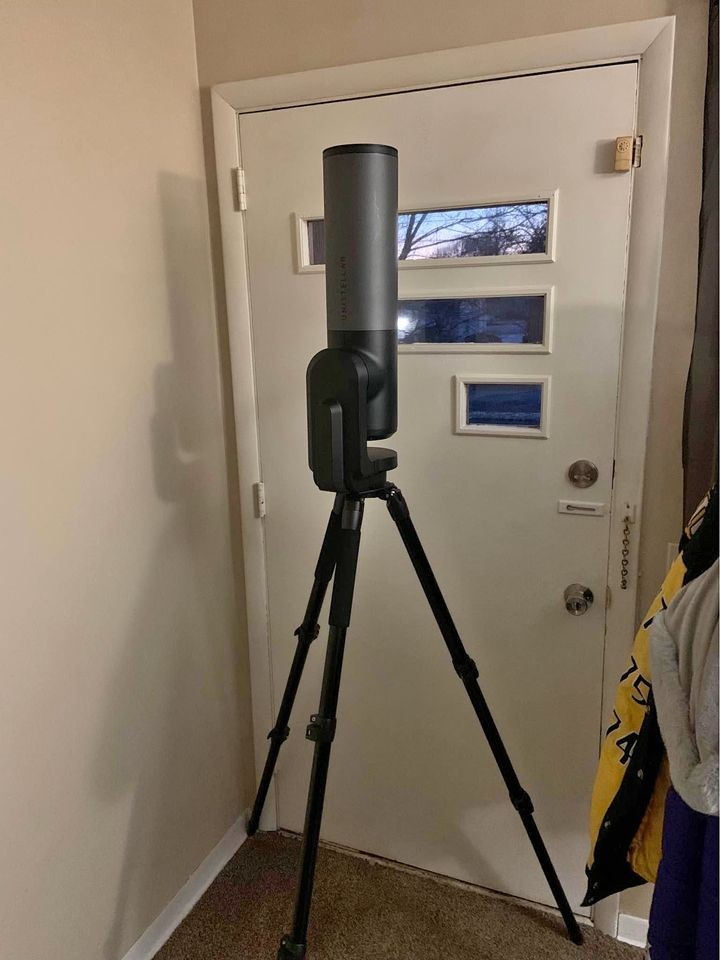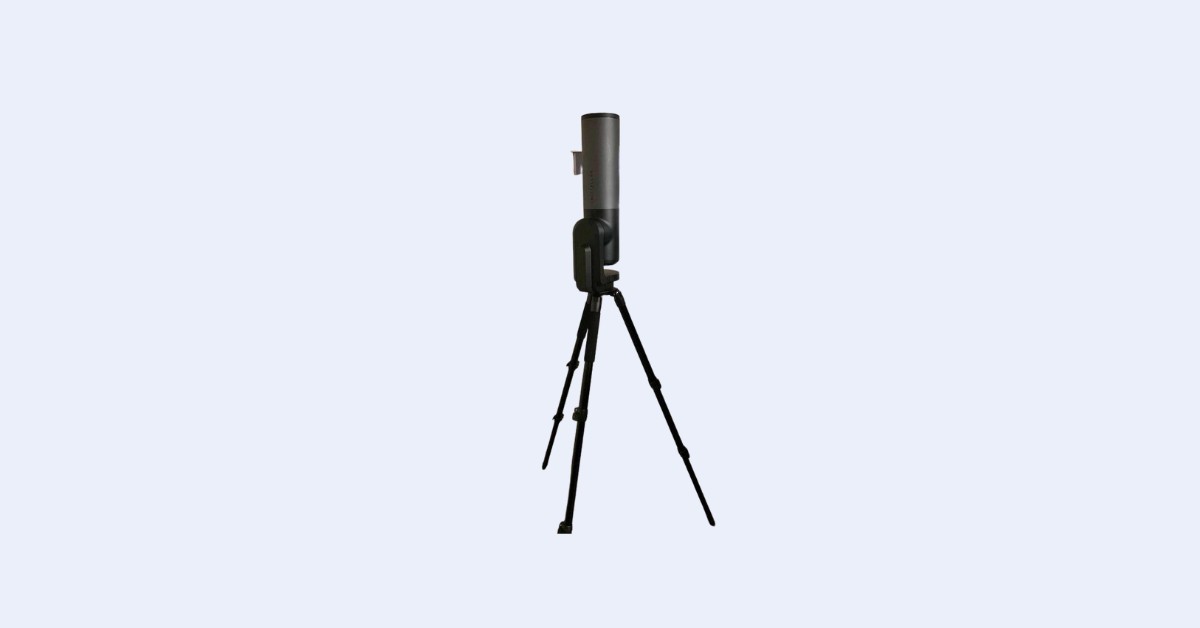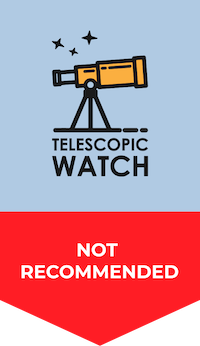The Optical Tube
The eVscope eQuinox is a simple 114mm f/3.9 reflector telescope (450mm focal length). It uses the same primary mirror as the Zhumell Z114, Orion StarBlast 4.5 Astro, and similar 114mm f/3.9 reflectors, but replaces the secondary mirror with a Sony IMX224 CMOS camera sensor. Because of this, there is no need to worry about eyepieces, as the telescope is designed to capture images that can be viewed on a smartphone or tablet rather than looking into the telescope with an eyepiece. The lack of an eyepiece makes focusing the telescope a lot more tedious, but the package includes a Bahtinov mask that you can place over the front of the telescope to help with dialing it in. Autofocus technology for astrophotography telescopes and regular digital cameras is commonplace, and it would’ve been extremely easy to add to the eVscope eQuinox, but Unistellar simply can’t be bothered to give you an extra motor for your multi-thousand-dollar device to enable such a capability.

I find the cosmetics of the optical tube to be nothing to write home about, consisting of a “meteor gray” color with Unistellar printed on the side. It’s not made of the most rigid materials either, featuring double walls with thin aluminum on the outside and an unfortunately reflective satin black plastic on the inside. One of the obvious disadvantages of this I’ve noticed is that it’s not nearly as absorbent of stray light as it could be with a flat black or other material. For a telescope that costs this much, such a design choice is quite frankly ridiculous when you look at the premium apochromatic refractors sold for imaging purposes at around the same amount.
Lastly, at the end of the tube is a spider that holds the central camera sensor in place at the focal point of the mirror, rather than the typical Newtonian-style secondary mirror. Because of this, the tube is a few inches longer than a regular Newtonian telescope of similar focal length.
Camera & Software Capabilities
The eVscope eQuinox, like the original eVscope, features a Sony IMX224 sensor, which is the same 1.27-megapixel sensor found in popular astronomy cameras like the ZWO ASI224MC and the QHY 224C. For a telescope built with primarily deep-sky imaging in mind, it would have been far more logical for them to utilize a wider sensor with larger pixel sizes rather than the small, cheap IMX224, a sensor that shines best in the roles of planetary imaging and auto-guiding, not for long exposures of deep space. You can tell that Unistellar’s priorities here were for cost savings wherever possible, including skimping on arguably the most important part of the package.
One of the primary aspects of the package that you are paying for is the included Unistellar software, which is available on both Apple and Android smartphones and tablets alike. The app is essentially your command center, allowing you to control the telescope’s movement and settings as well as view its images. In order to connect the eVscope to the app, the telescope creates its own wireless access point that you can then connect your smartphone or tablet to.
From there, the Unistellar app syncs up with your device’s GPS location to assist in orienting the eVscope. One of the nicest parts of the app is the sky catalog, offering the location and a description of over 5,000 different objects. The sorting and filtering in the app are very rudimentary but work well. It allows you to filter objects based on their type (planets, galaxies, nebulae, etc), as well as if they’re above the horizon at your location. You can also sort the catalog by alphabetical order, proximity to the telescope’s current location in the sky, or by recommendation.
The next tab offers another nifty feature: the opportunity to contribute to scientific observations. Using coordinates that can be pulled off of the Unistellar website, you can use the eVscope to record and track asteroid occultations, exoplanet transits, comets, and others. While the design of the eVscope isn’t particularly built for science, the idea of being able to contribute your data with the push of a few buttons is probably one of the most compelling arguments for the telescope for those interested, and really the only thing you’d be hard-pressed to figure out on your own with a different setup.
The third tab over is the photo gallery and telescope control, where you can see your images and prepare the telescope for pointing and observation. The controls allow you to make both rough and fine adjustments on the pointing, but the automatic alignment of the eVscope seems to be very good at centering objects on the first try. However, a caveat to this is that sometimes the automatic plate solving will fail if there are clouds or if it’s not dark enough for the eVscope to ‘see’ the star field.
Lastly, the Unistellar app has a settings tab where you can adjust your photo-saving options, focus, orientation, and sensor calibration while being able to see the battery life and storage capacity of the telescope.
Mount
The eVscope eQuinox comes standard with a heavy-duty camera tripod and a single motorized fork arm that grasps onto the tube. With its simplicity comes a very easy time setting up as well; just fold out the tripod, level it, and screw the telescope onto it with the two provided thumbscrews and you’re pretty much ready to go.
I’ve assessed the build quality of the eVscope’s tripod as simply just “mediocre. Unistellar could definitely afford to make a few minor design changes that would make a world of difference. For one, the telescope is only secured to the tripod head using two thumb screws instead of a more stable three, which could allow things to shift around slightly on the tripod head. Secondly, the ends of the tripod legs are tipped with inadequate rubber feet that don’t seem to help much with vibrations, causing the eVscope to throw out errors if jostled by wind or movement around the telescope.
For the multi-thousand-dollar price tag, you would think that the fork mount might be made of something other than plastic, but that does not seem to be the case with the eVscope eQuinox, which is extremely disappointing. If the telescope ever were to get dropped or topple over on accident, we would definitely worry about the mount being damaged or potentially even destroyed.
Performance
The IMX224 sensor in the eVscope eQuinox is, of not cooled, which leads to higher levels of noise, especially when it heats up during a long exposure. The alt-azimuth nature of the telescope’s mount would also blur long exposures due to its insufficient tracking accuracy and “star-step” motion across the sky. The eVscope eQuinox attempts to counteract these problems by opting for stacking multiple, usually short, exposures, which keeps noise from building up as much (though it hardly solves it). Unistellar sometimes calls this “enhanced vision technology”. This is a lie. They have not invented any technology whatsoever, but are rather using the well-known astrophotography technique of stacking, specifically live stacking.
Stacking is how real deep-sky astrophotography works, but real astrophotography would use a more well-optimized sensor, as well as integration or total exposure times of hours, and plenty of post-processing. “Live stacking” exposures of a few minutes with a cheaply-made system and attempting to process in real-time is obviously going to be a disappointment. It pales in comparison to real astrophotography, lacks the dynamic range or contrast of actual visual observation, and of course robs you of actually looking directly at the objects themselves; the photons that traveled thousands, millions, or even billions of light-years to reach the telescope never directly go into your eyeball.
The IMX224 sensor’s small size means that it not only provides a stupidly small field of view for a 450mm focal length instrument, but its uncooled nature means that the image is filled with noise and hot pixels, which outnumber stars even in a dense cluster, and an exposure of a few minutes is hardly enough to build up enough of a signal. The app cranks up the gain on many objects way too much to compensate for the almost always too-short exposure time, making for even worse-quality images. This exacerbates the noise and hot pixels. As a result, I’ve seen that the images the scope puts up are just jokingly bad, and it would be extremely hard for you to even come close to the high-quality photos used in marketing without a level of exposure time and post-processing that most users may not even be able to squeeze out of the telescope.
There is also no broadband light pollution filter in the eVscope eQuinox, which means that the eVscope is more affected by light pollution than a good astrophotography rig and is not immune to it like the marketing claims.
The short focal length of the eVscope, combined with the inability to add a Barlow lens attachment, makes the eVscope largely unsuitable for planetary imaging, which is ironic considering the sensor choice. A cheap telescope with a comparable aperture to the eVscope eQuinox, like the Orion StarBlast or Zhumell Z114, will provide you with razor-sharp views of Jupiter’s cloud belts and even the disks of its moons, not a blurry blob with barely-visible cloud belts. Along with that, the field of view is just small enough to where the Moon is cropped, which might be annoying to some. Double stars are also a poor target choice and will often end up looking like a blob rather than a split binary because of the exposure settings of the sensor.
Should I buy a Used Unistellar eVScope eQuinox?
We would recommend avoiding a used eVscope eQuinox in any form due to its disappointing performance and the number of things that can go wrong with a used purchase. Ironically, the presence of so many used units floating around for a telescope this expensive should really be a warning as to just how much of a disappointment it is; it is not normal to return or immediately ditch such an expensive product for any reason, and it is also not normal for used units to be sold at such a ridiculous discount (often half off the new price for a barely-touched scope).
Because the eVscope eQuinox is one completely integrated system, if something goes wrong with it, it can render the entire thing useless. Since the parts are not easily replaceable or self-repairable, we do not recommend purchasing one used. Unistellar does offer a 2-year warranty from the purchase date that also covers second-hand purchases, but it is void if the telescope was modified in any way, either by you or the previous owner, which may be hard to determine if you are purchasing a pre-owned from somewhere other than a trusted vendor of telescopes.
Alternative Recommendations
There are no 1:1 equivalents to the eVscope eQuinox because it is not exactly something you’d want to duplicate – but we’ve picked out a few options that can somewhat fulfill its functions:
- The Vaonis Vespera is a similar all-in-one package to the eVscope eQuinox, but without the pitfalls of the eVscope’s design and without any false promises either. It’s more compact, easier to use, has a wider field, and utilizes a better camera sensor and other technological improvements to put up comparable images to a decent wide-field astrophotography rig with a little less fuss. However, like the eVscope, there is no eyepiece nor modularity like a regular astrophotography rig, and Solar System capabilities are limited.
- The Celestron Nexstar Evolution 8 is a lot larger and bulkier than the eVscope, but also contains a built-in battery and WiFi.. The great thing about this is that while it uses an eyepiece instead of a camera, you can still attach a cheap planetary camera to it and take far higher quality planetary images than the eVscope would ever be capable of and even do some deep-sky astrophotography too.
- The Sky-Watcher 12” Flextube Collapsible Dobsonian is a great choice for those hungry for aperture while wanting to maintain some portability. While this is far more manual than the eVscope, a GoTo version is available.
- The Sky-Watcher Virtuoso GTi 150P is a much cheaper option than the eVscope eQuinox that still has hassle-free GoTo, a wide field of view, and plenty of portability. A small planetary camera can even be attached too!
Aftermarket Accessory Recommendations
There are not very many accessory recommendations we can make for the eVscope eQuinox since this scope is an integrated package, but Unistellar offers a high-density foam travel backpack for the eVscope. The Unistellar backpack is outrageously overpriced for what it is, so we recommend just purchasing a basic padded case or backpack that can fit it.
For humid nights, we also recommend investing in a wrap-around dew shield, since condensation has the possibility of forming on the image sensor and preventing the telescope from working properly.



